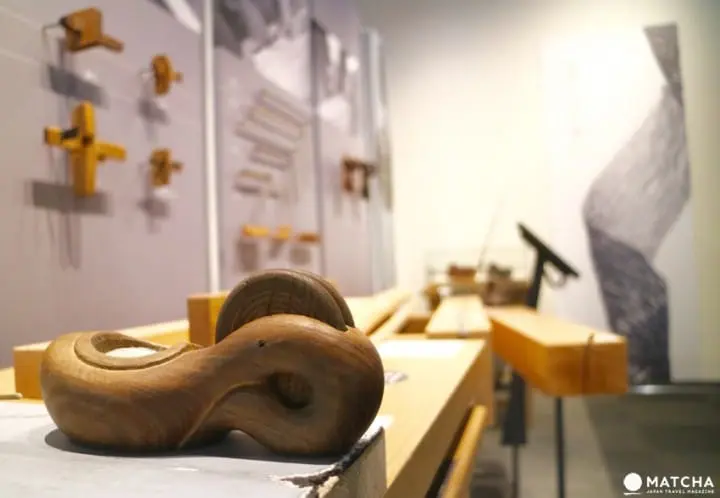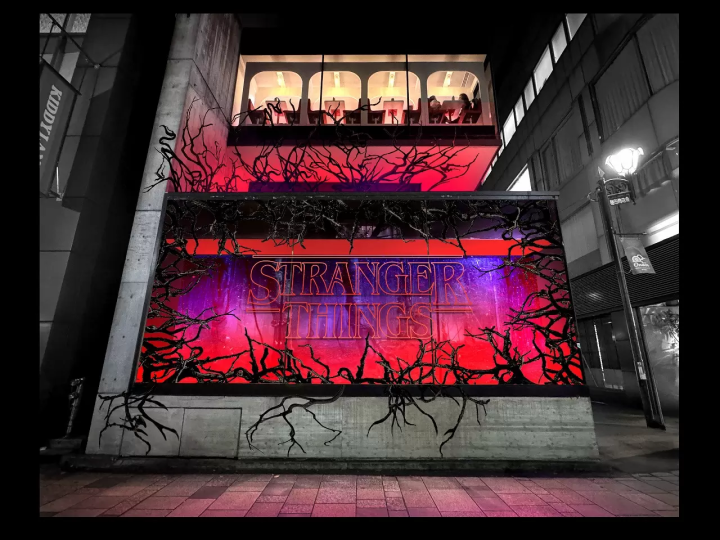Takenaka Carpentry Tools Museum: Learn All About Japanese Architecture

Takenaka Carpentry Tools Museum in Kobe is the only museum where visitors can learn and experience the technology of Japanese wooden architecture.
2. The Splendid Interior

The entrance door is made from chestnut. The admission fee is 500 yen for adults, 200 yen for senior citizens over the age of 65 and 300 yen for university and high school students. Junior high school students and children under that age can enjoy the museum for free. All prices include tax.
There is also a locker room to store your bags. Please note that credit cards are not accepted at this museum.

The stairs on the left lead to the underground exhibition floors. The stripes on the wall are made using a traditional technique called tsuchikabe kezuridashi (plastered earthen wall).

Visitors can sit on the stylish chairs at the bottom of the stairs. Many people use this space when they want to take a break.

The underground floors are luminous, as the museum has a inner courtyard to bring in natural light. This museum charms visitors with its intricate design and construction.
3. The Fragrant Exhibitions


The photograph shows one of the highlights of this museum. This is a full scale model of the kumimono which connects the roof and columns of the Toshodaiji Temple Kondo, located in Nara prefecture.
The huge exhibition spans the two basement floors.

This exhibition titled Making the Most of Wood is located on the second basement floor. Visitors can learn about the various colors, grain and fragrance of each type.

The photograph shows the shoji (sliding doors) displayed at the exhibition titled The Traditional Beauty of Japanese Wa. They have been created in the traditional style, using a technique called kumiko.
The beautiful patterns are made without using any nails or glue, and bring out the natural colors of the wood. When illuminated, they cast an amazing shadow too.

The sumi tsubo (inkpot), displayed at the exhibition entitled Tools and Handwork, is used to draw straight sumi (Japan ink) lines on wood.

Visitors can actually touch displays which have "feel free to touch" signs.
There are seven exhibitions in all, including displays about the history of Japanese architecture and craftsmen who built the tools for carpentry. Taking photographs in the museum is allowed, provided that the photographs are for personal use only.
4. Workshops

A workshop titled chokotto mokko (a small amount of woodwork) is held at the second basement floor on Wednesdays, Saturdays, Sundays and national holidays, from 10:00 to 12:00 and 13:00 to 16:00. Please note that this workshop may not be held due to other events.
Kumiki puzzle is a class for making puzzle pieces using a fretsaw. It takes thirty to sixty minutes, and the fee is 500 yen, including tax.

"The wooden egg of Mt. Rokko" is another class for polishing a egg-shaped wood, using sandpaper. Small children can participate in this class, and the fee is 200 yen, including tax.
Although the classes are in Japanese, some of the participants are visitors from abroad, as the instructions do not require detailed explanations. Reservations are not required, but the morning classes may be better, as the afternoon classes tend to get crowded.
There are special classes in each season, along with the regular classes, so if you have the chance, give it a try. For details, please take a look at the event page of the museum's Japanese website.
5. Buying Souvenirs in the Museum Shop

The museum shop, located near the reception on the first floor, may feel a little small after seeing the exhibition spaces. It handles catalogues of the exhibitions held at the museum, along with unique wooden items.
The photograph shows accessory straps on the upper row, and key rings on the bottom row. Designed to look like traditional woodworking tools, they are both priced at 870 yen, including tax. From left to right: kanna (plane), kizuchi (wooden hammer) and nokogiri (saw).

The pencil sharpener, made from various types of wood with different colors and grains, is priced at 650 yen, including tax.

The wooden eggs with attractive grains are titled Gifts from the Birds in the Forest. They are priced according to the wood type; the enju (pagoda tree) and sakura (cherry) is priced at 1200 yen including tax, and the other eight types are all 1100 yen.
The eggs are warm to the touch.

Although it isn't made from wood, their tenugui (hand towel) is also a popular souvenir. The names of the wood displayed at the museum, such as tsuge (boxwood) and tsuga (hemlock), are printed on the tenugui, in both kanji and hiragana.
The white tenugui is priced at 1000 yen, and the blue tenugui is 1100 yen, both including tax. There are also other light and compact items fit for souvenirs, such as pencils and post cards.
Services for Visitors from Abroad

All the signs have English translations, and some of them are translated into Korean and Chinese.
Although the comments are written only in Japanese, the museum offers a guidance tool in English, Korean and Chinese, which can be used on a tablet or a smartphone. Just ask the staff at the reception.

Due to the charming architecture, unique exhibitions and multilingual services, the number of visitors from abroad has been growing steadily. People from over fifty countries came to the museum last year.
On the day of our visit, a French family came to the museum. The lady on the left told us that "the exhibition is well-designed, and based on a firm philosophy."
Takenaka Carpentry Tools Musuem can be enjoyed in many ways, so if you're visiting Kobe, be sure to drop by the museum.
This article was written in co-operation with the Takenaka Carpentry Tools Museum.
日本文化、特に絵画や工芸品が好き。福岡、京都、大阪、ベルギー、アメリカを経て現在は神戸在住。座右の銘は「住めば都」。





































![[2026 Edition] FORMUAL 1 JAPANESE GRAND PRIX Information](https://resources.matcha-jp.com/resize/720x2000/2025/10/05-245984.webp)


![[2025 Update] Namba's spectacular illuminations! "Namba Hikari Tabi" with approximately 1 million shining lights](https://resources.matcha-jp.com/resize/720x2000/2025/12/12-252825.webp)